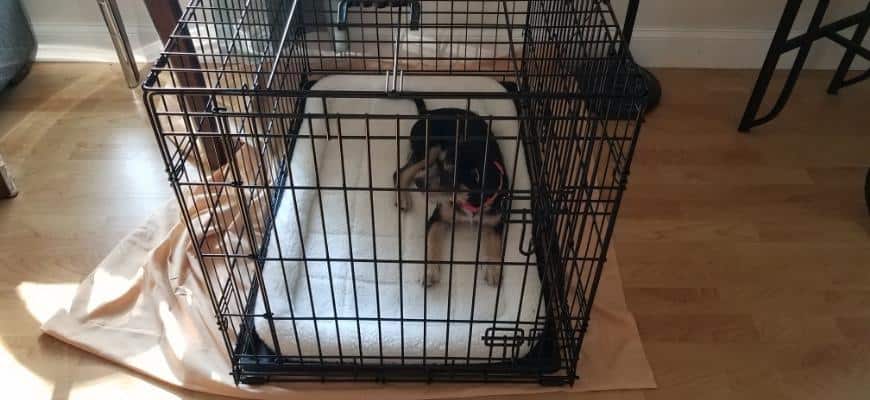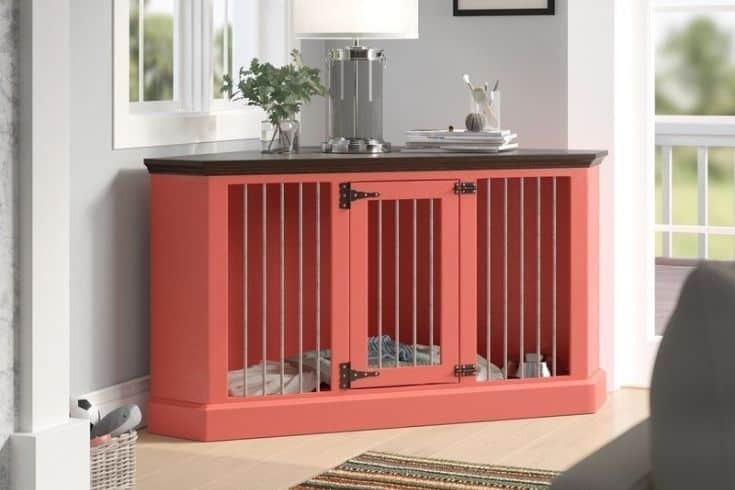Yes, you should cover your dog’s crate with a blanket if your dog is feeling cold, suffers from anxiety, is noise sensitive or is having trouble falling asleep due to lights in the house. However if you do decide to cover your dog’s crate with a blanket you need to be aware of the risks such as overheating, the high flammability of blankets and also how they pose a choking hazard. Remember when covering a dog crate with a blanket you should always leave at least one side uncovered to provide adequate air flow.
What Kind Of Crate Needs A Cover?
Not all dog crates are made equal and not all need covers.

Wire dog crates are a hugely popular choice for many dog owners.
Wire crates are relatively cheap to buy, they’re easy to clean, most are collapsible for easy storage and portability, and a wire crate is well-ventilated, too.
Also, if you buy a wire crate with a divider, your pet can use the same crate from puppyhood to adulthood, as you can use the crate divider to gradually enlarge the crate as the puppy grows. Wire crates with dividers are also excellent potty training tools.
The main downside to wire crates is that they allow your puppy a 360-degree view of his world. That makes it very difficult for some dogs to settle. For example, the smallest movement outside windows onto the street can immediately have some dogs barking.
So, covering a wire dog crate is a good way of cutting out drafts, keeping your dog warm, cutting out distractions, and providing your pet with privacy.
Plastic crates are generally used for safe travel in a vehicle. In fact, most airlines insist that you transport your dog in a plastic travel crate as hold baggage.
An airline-style plastic crate is well ventilated but is also more enclosed than a wire crate, so you might not need a crate cover to keep your pet calm or warm. Also, covering a plastic crate can lead to your dog overheating.

Furniture crates are designed to double as attractive pieces of furniture, such as end tables or media consoles.
These crates are usually enclosed on three sides, so a cover is not required.
Soft-sided, fabric crates are usually used as travel crates for small to medium-sized dogs. These crates are fairly well enclosed, so it’s not generally essential that you use a crate cover. Again, covering a soft-sided crate can cause the occupant to overheat and cuts off essential ventilation, too.
Never cover all sides of a dog crate!
One side of the crate must always be left uncovered so that your dog receives plenty of fresh air.
Ensure that the crate is placed in a spot where there are no drafts so that you can leave one side of the crate exposed to the air without fear that your dog will get chilled.
6 Reasons Covering A Dog Crate Is A Good Idea
Covering your dog’s crate with a blanket will help deafen the noise from the surrounding area.
This will help make your pups safe space even more of a sanctuary as they won’t have as many interruptions when napping.
This obviously won’t make their crate completely soundproof. But, it will definitely help reduce some noises like appliances, the television, thunderstorms, etc.
Should You Cover a Dog Crate With a Blanket?
This is perhaps the single most asked question regarding crate training. So I will cover this separately just below. Then I’ll go through 9 more things you can do to help your puppy enjoy his crate.
By putting a cover or blanket over the top of the crate, you’re essentially making it more “den-like”. Sometimes this works well, but other times it does not.
By covering the top, back and sides, or just the top, it’s thought to be more calming for your pup. The environment will be slightly darker, warmer, quieter, and there’ll be fewer distractions.
If there’s less stimulation, it may make it easier for your puppy to relax and be calm while inside his crate.